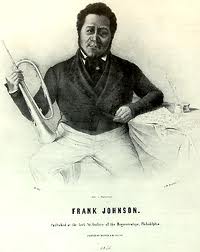Annotation:Juliana: Difference between revisions
No edit summary |
No edit summary |
||
| Line 1: | Line 1: | ||
'''Back to [[{{BASEPAGENAME}}]]''' | =='''Back to [[{{BASEPAGENAME}}]]'''== | ||
---- | ---- | ||
<p><font face="garamond, serif" size="4"> | <p><font face="garamond, serif" size="4"> | ||
'''JULIANA'''. English, Jig. G Major (Miller): C Major (Barnes): A Major (Kennedy). Standard tuning (fiddle). AAB (Kennedy, Miller): AABBCC (Barnes). The melody appears in dancing master Thomas Wilson's '''Companion to the Ball Room''' (London, 1816). A version of the tune also appears in Edward Riley's '''Flute Melodies''' (New York, 1814, p. 62) and in the music manuscript collection of Frank Johnson, inscribed "Presented to Mrs. A. Rush by Frank Johnson, a Black Musician" (Historical Society of Pennsylvania, Philadelphia). Francis A. Johnson [http://chevalierdesaintgeorges.homestead.com/johnsonf.html] (1792-1844) was an African-American musician, principally a coronet player, who rose from humble beginnings to become one of Philadelphia's premier bandleaders in the early 19th century. | '''JULIANA'''. English, Jig. G Major (Miller): C Major (Barnes): A Major (Kennedy). Standard tuning (fiddle). AAB (Kennedy, Miller): AABBCC (Barnes). The melody appears in dancing master Thomas Wilson's '''Companion to the Ball Room''' (London, 1816). A version of the tune also appears in Edward Riley's '''Flute Melodies''' (New York, 1814, p. 62) and in the music manuscript collection of Frank Johnson, inscribed "Presented to Mrs. A. Rush by Frank Johnson, a Black Musician" (Historical Society of Pennsylvania, Philadelphia). Francis A. Johnson [http://chevalierdesaintgeorges.homestead.com/johnsonf.html] (1792-1844) was an African-American musician, principally a coronet player, who rose from humble beginnings to become one of Philadelphia's premier bandleaders in the early 19th century. In England, the jig was entered into the large 1840 music manuscript collection of multi-instrumentalist John Rook (Waverton, near Wigton, Cumbria). | ||
[[File:francisjohnson.jpg|200px|thumb|left|Francis Johnson]] | [[File:francisjohnson.jpg|200px|thumb|left|Francis Johnson]] | ||
<br> | <br> | ||
| Line 23: | Line 23: | ||
<br> | <br> | ||
---- | ---- | ||
'''Back to [[{{BASEPAGENAME}}]]''' | =='''Back to [[{{BASEPAGENAME}}]]'''== | ||
Revision as of 20:24, 11 May 2017
Back to Juliana
JULIANA. English, Jig. G Major (Miller): C Major (Barnes): A Major (Kennedy). Standard tuning (fiddle). AAB (Kennedy, Miller): AABBCC (Barnes). The melody appears in dancing master Thomas Wilson's Companion to the Ball Room (London, 1816). A version of the tune also appears in Edward Riley's Flute Melodies (New York, 1814, p. 62) and in the music manuscript collection of Frank Johnson, inscribed "Presented to Mrs. A. Rush by Frank Johnson, a Black Musician" (Historical Society of Pennsylvania, Philadelphia). Francis A. Johnson [1] (1792-1844) was an African-American musician, principally a coronet player, who rose from humble beginnings to become one of Philadelphia's premier bandleaders in the early 19th century. In England, the jig was entered into the large 1840 music manuscript collection of multi-instrumentalist John Rook (Waverton, near Wigton, Cumbria).

Source for notated version:
Printed sources: Barnes (English Country Dance Tunes, vol. 2), 2005; p. 68. Kennedy (Jigs & Quicksteps, Trips & Humours), 1997; No. 90, p. 22. Miller (Fiddler's Throne), 2004; No. 65, p. 49. Wilson (Companion to the Ball Room), 1816; p. 118.
Recorded sources:
